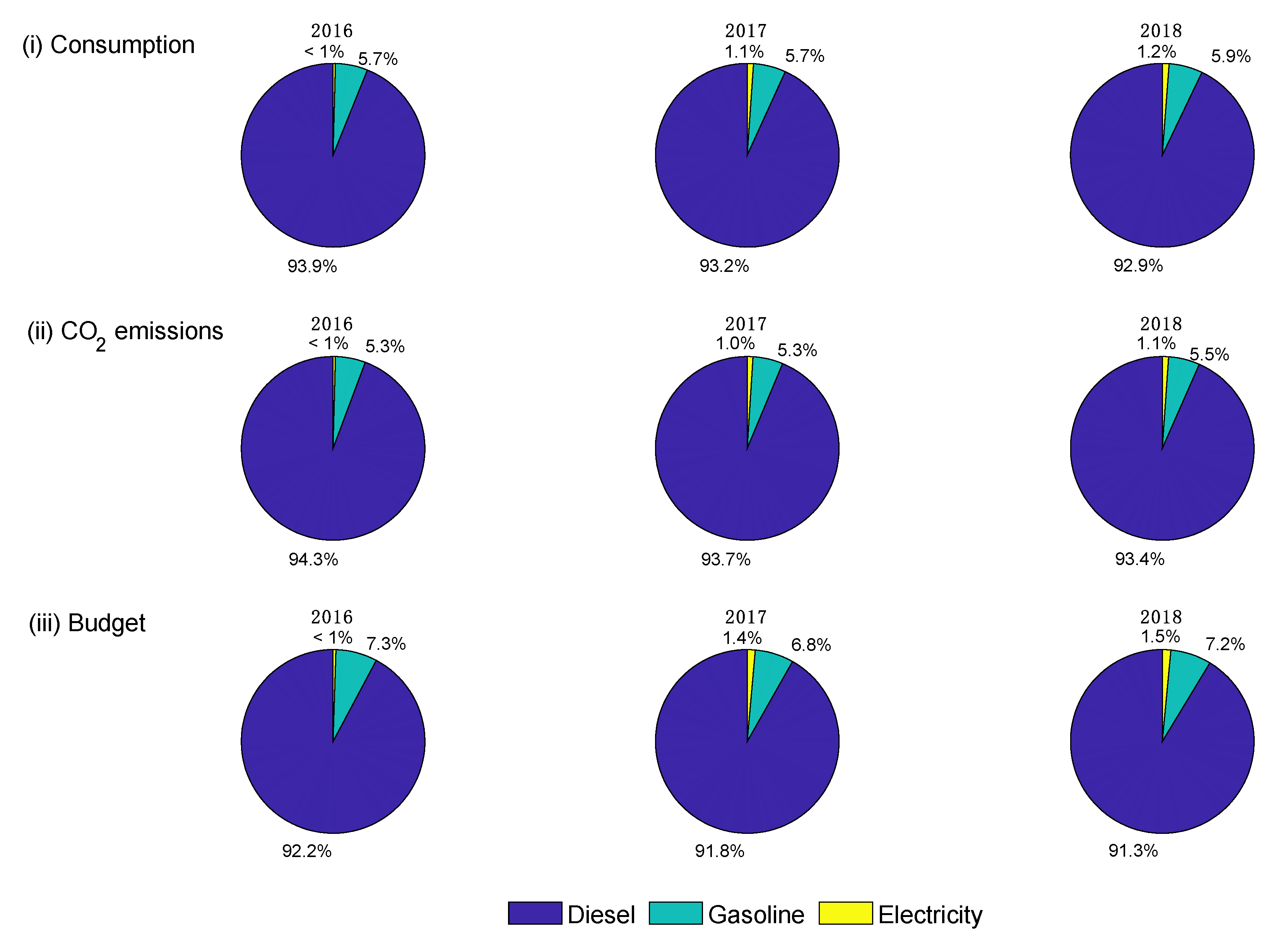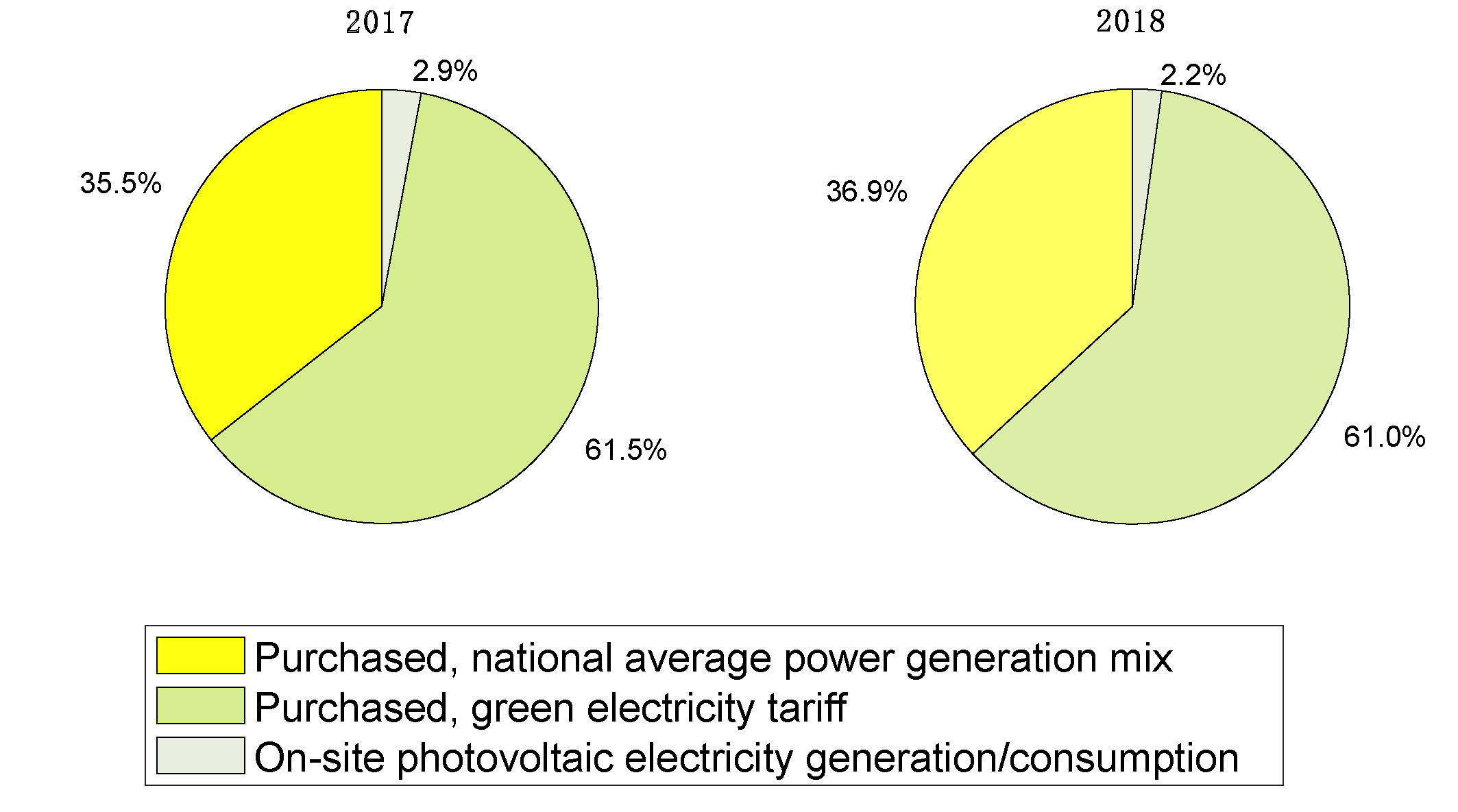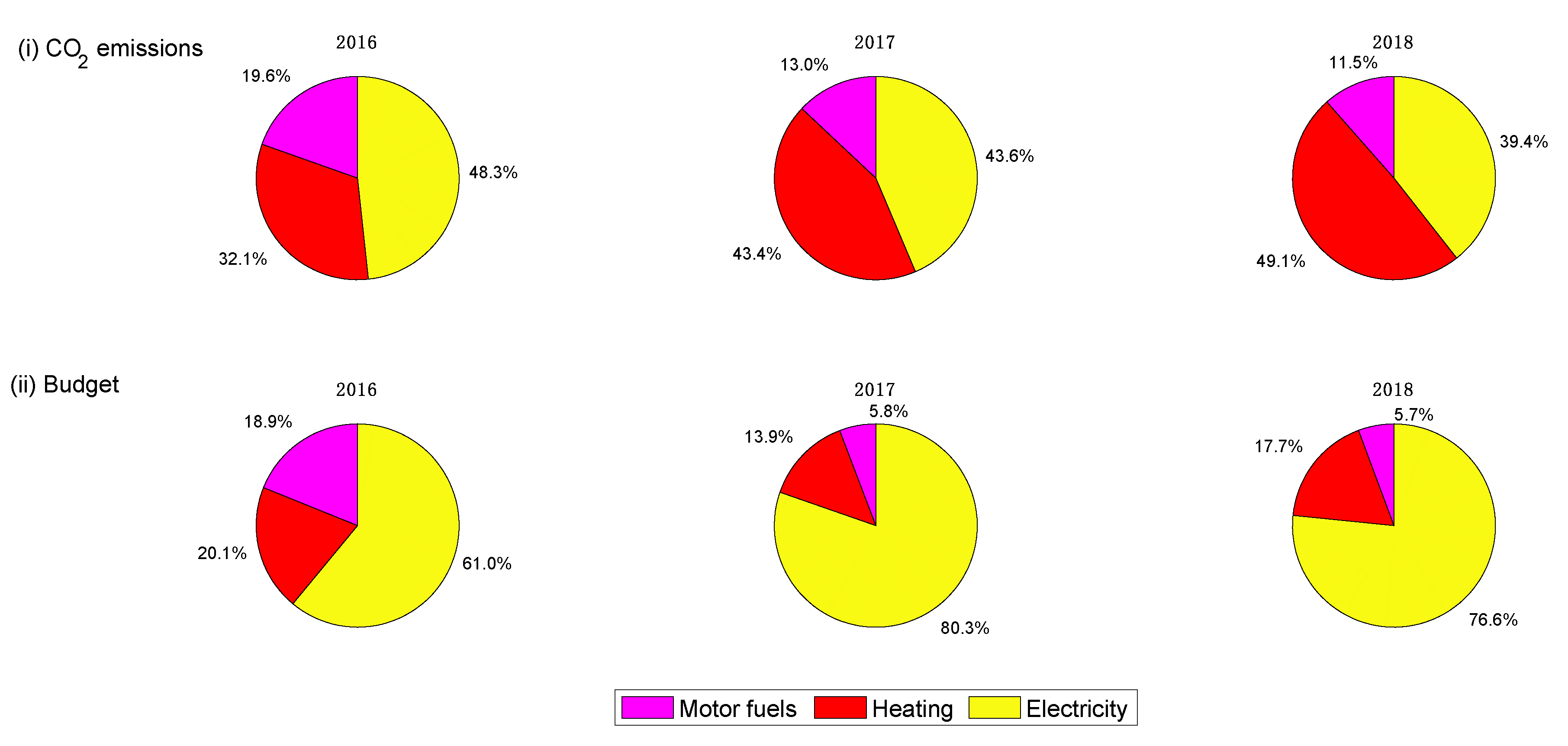Sustainable Performances of Small to Medium-Sized Airports in the Adriatic Region
Abstract
:1. Introduction
Literature Review
2. Methods and Data Sets
2.1. Airport Characteristics and Dataset
2.2. Statistical Analysis and Calculations
3. Results
3.1. Performance Indicators for Water and Energy Consumption
3.2. Carbon Dioxide Emissions Deriving from Energy Consumption
3.3. Budgets Related to Water and Energy Consumption
3.4. Contribution of Different Types of Fuel and Electricity to Energy Consumption, CO2 Emissions, and Budget
4. Discussion
5. Conclusions
Author Contributions
Funding
Data Availability Statement
Acknowledgments
Conflicts of Interest
Appendix A

| NUTS 3 | 2016 | 2017 | 2018 |
|---|---|---|---|
| Bari | 1387.23 | 1586.08 | 1331.62 |
| Brindisi | 970.11 | 1202.92 | 1016.94 |
| Dubrovnik-Neretva | 1304.49 | 1471.97 | 1301.86 |
| Istria | 1768.32 | 1907.82 | 1718.61 |
| Pescara | 1114.06 | 1361.28 | 1389.86 |
| Rimini | 1885.47 | 1830.5 | 1859.04 |
| NUTS 3 | 2016 | 2017 | 2018 |
|---|---|---|---|
| Bari | 246.12 | 415 | 250.19 |
| Brindisi | 341.85 | 430.35 | 394.68 |
| Dubrovnik-Neretva | 346.1 | 403.85 | 437.66 |
| Istria | 166.47 | 222.69 | 205.62 |
| Pescara | 349.96 | 378.58 | 262.01 |
| Rimini | 150.21 | 334.29 | 180.28 |
| Measures | Airports (%) |
|---|---|
| Training and education of airport staff | 67 |
| Monitoring of water consumption | 50 |
| Harvest and reuse of rainwater | 33 |
| Initiatives aiming at reducing water consumption (in place or plan to implement) | 50 |
| Surface water and groundwater quality monitoring | 67 |
| Initiatives to prevent groundwater pollution (in place) | 67 |
| Measures | Airports (%) |
|---|---|
| On-site photovoltaic electricity production (in place or plan to implement) | 83 |
| New operational and maintenance procedures to improve and optimize energy efficiency and improvements in heating, ventilation, and air conditioning | 83 |
| Actions to improve management systems and energy facilities (i.e., installing new metres and a building management system in the gates area; rebuilding the terminal and purchasing new equipment; installing a cogeneration plant and improving the energy efficiency of the passenger terminal) | 50 |
| LED lighting | 100 |
| Measures | Airports (%) |
|---|---|
| Switching from vehicles burning diesel fuels to vehicles burning bio-fuels or powered by electricity generated from renewable sources (in place or plan to implement) | 83 |
| Charging stations for electric vehicles (in place or plan to implement) | 100 |
References
- European Environment Agency (EEA). Aviation and Shipping—Impacts on Europe’s Environment—TERM 2017: Transport and Environment Reporting Mechanism (TERM) Report, EEA Report No. 22/2017. 2017. Available online: https://www.eea.europa.eu/publications/term-report-2017 (accessed on 9 June 2021).
- European Environment Agency (EEA). Transport and Environment Report 2020—Train or Plane? EEA Report No. 19/2020. 2020. Available online: https://www.eea.europa.eu/publications/transport-and-environment-report-2020 (accessed on 5 July 2021).
- European Commission. Communication from the Commission to the European Parliament, the Council, the European Economic and Social Committee and the Committee of the Regions Sustainable and Smart Mobility Strategy—Putting European Transport on Track for the Future. COM/2020/789 Final. 2020. Available online: https://eur-lex.europa.eu/legal-content/en/TXT/?uri=CELEX%3A52020DC0575 (accessed on 19 April 2021).
- European Commission. Communication from the Commission to the European Parliament, the European Council, the Council, the European Central Bank, the European Economic and Social Committee, the Committee of the Regions and the European Investment Bank Annual Sustainable Growth Strategy 2021. COM/2020/575 Final. 2021. Available online: https://eur-lex.europa.eu/legal-content/en/TXT/?uri=CELEX:52020DC0575 (accessed on 3 July 2021).
- Eurostat. Share of Energy from Renewable Sources. [nrg_ind_ren]. 2021. Available online: https://appsso.eurostat.ec.europa.eu/nui/show.do?dataset=nrg_ind_ren&lang=en (accessed on 3 July 2021).
- European Commission. Directive 2009/28/EC of the European Parliament and of the Council of 23 April 2009 on the Promotion of the Use of Energy from Renewable Sources and Amending and Subsequently Repealing Directives 2001/77/EC and 2003/30/EC. 2009. Available online: http://data.europa.eu/eli/dir/2009/28/oj (accessed on 3 July 2021).
- Ministry of Environment and Energy of the Republic of Croatia. Integrated National Energy and Climate Plan for the Republic of Croatia for the Period 2021–2030. 2019. Available online: https://mingor.gov.hr/UserDocsImages/UPRAVA%20ZA%20ENERGETIKU/Strategije,%20planovi%20i%20programi/hr%20necp/Integrated%20Nacional%20Energy%20and%20Climate%20Plan%20for%20the%20Republic%20of_Croatia.pdf (accessed on 2 March 2021).
- Republic of Croatia (Ministry of the Sea, Transport and Infrastructure). Transport Development Strategy of the Republic of Croatia (2017–2030). 2017. Available online: https://mmpi.gov.hr/UserDocsImages/dokumenti/INFRASTRUKTURA/Infrastruktura%2010_19/Transport%20Development%20Strategy%20of%20the%20Republic%20of%20Croatia%202017-2030%2029-10_19.pdf (accessed on 3 June 2021).
- Italian Republic (Ministry of Economic Development, Ministry of the Environment and Protection of Natural Resources and the Sea, Ministry of Infrastructure and Transport). Integrated National Energy and Climate Plan. 2019. Available online: https://ec.europa.eu/energy/sites/ener/files/documents/it_final_necp_main_en.pdf (accessed on 28 July 2021).
- Interreg—The portal to all Interreg programmes, financed by the EU. Available online: https://interreg.eu/ (accessed on 26 November 2021).
- About the Project—ADRIGREEN—Italia—Croatia. Available online: https://www.italy-croatia.eu/web/adrigreen (accessed on 26 November 2021).
- European Commission. Annual Analyses of the EU Air Transport Market 2016. 2017. Available online: https://ec.europa.eu/transport/sites/default/files/2016_eu_air_transport_industry_analyses_report.pdf (accessed on 9 March 2021).
- Martini, G.; Manello, A.; Scotti, D. The influence of fleet mix, ownership and LCCs on airports’ technical/environmental efficiency. Transp. Res. Part E Logist. Transp. Rev. 2013, 50, 37–52. [Google Scholar] [CrossRef]
- Airports Council International (ACI). Interim Report 2019–2020. 2021. Available online: https://www.airportcarbonaccreditation.org/aca-media/annual-reports.html (accessed on 19 May 2021).
- Baltazar, M.E.; Rosa, T.; Silva, J. Global decision support for airport performance and efficiency assessment. J. Air Transp. Manag. 2018, 71, 220–242. [Google Scholar] [CrossRef] [Green Version]
- Kılkış, Ş.; Kılkış, Ş. Benchmarking airports based on a sustainability ranking index. J. Clean. Prod. 2016, 130, 248–259. [Google Scholar] [CrossRef]
- Chao, C.C.; Lirn, T.C.; Lin, H.C. Indicators and evaluation model for analyzing environmental protection performance of airports. J. Air Transp. Manag. 2017, 63, 61–70. [Google Scholar] [CrossRef]
- Comendador, V.F.G.; Valdés, R.M.A.; Lisker, B. A holistic approach to the environmental certification of green airports. Sustainability 2019, 11, 4043. [Google Scholar] [CrossRef] [Green Version]
- De Castro Carvalho, I.; Calijuri, M.L.; Assemany, P.P.; e Silva, M.D.F.M.; Neto, R.F.M.; da Fonseca Santiago, A.; de Souza, M.H.B. Sustainable airport environments: A review of water conservation practices in airports. Resour. Conserv. Recycl. 2013, 74, 27–36. [Google Scholar] [CrossRef] [Green Version]
- Eurostat. Heating and Cooling Degree Days—Statistics. 2021. Available online: https://ec.europa.eu/eurostat/statistics-explained/index.php?title=Heating_and_cooling_degree_days_-_statistics#Heating_and_cooling_degree_days_at_EU-27_level (accessed on 3 July 2021).
- Krtkovaá, E.; Risto, S.; Müllerová, M. Approximated EU Greenhouse Gas Inventory Proxy GHG Emission Estimates for 2019. Eionet Report—ETC/CME 1/2020; ETC on Climate Change Mitigation and Energy: Copenhagen, Denmark, 2020. [Google Scholar]
- Baxter, G.; Srisaeng, P.; Wild, G. An assessment of airport sustainability, part 2—Energy management at Copenhagen Airport. Resources 2018, 7, 32. [Google Scholar] [CrossRef] [Green Version]
- Airports Council International (ACI). Guide to Airport Performance Measures. 2012. Available online: http://www.aci.aero/Media/aci/downloads/ACI_APM_Guidebook_2_2012.pdf (accessed on 19 November 2020).
- Baxter, G.; Srisaeng, P.; Wild, G. An assessment of airport sustainability: Part 3—Water management at Copenhagen Airport. Resources 2019, 8, 135. [Google Scholar] [CrossRef] [Green Version]
- Kotopouleas, A.; Nikolopoulou, M. Thermal comfort conditions in airport terminals: Indoor or transition spaces? Build. Environ. 2016, 99, 184–199. [Google Scholar] [CrossRef] [Green Version]
- Jakubcionis, M.; Carlsson, J. Estimation of European Union service sector space cooling potential. Energy Policy 2018, 113, 223–231. [Google Scholar] [CrossRef]
- Alba, S.O.; Manana, M. Energy research in airports: A review. Energies 2016, 9, 349. [Google Scholar] [CrossRef] [Green Version]
- Greer, F.; Rakas, J.; Horvath, A. Airports and environmental sustainability: A comprehensive review. Environ. Res. Lett. 2020, 15, 103007. [Google Scholar] [CrossRef]
- Carlucci, F.; Cirà, A.; Coccorese, P. Measuring and explaining airport efficiency and sustainability: Evidence from Italy. Sustainability 2018, 10, 400. [Google Scholar] [CrossRef] [Green Version]
- Airports Council International Europe|ACI Europe—Regional Airports Forum. Available online: https://www.aci-europe.org/regional-airports-forum (accessed on 26 November 2021).
- Zuidberg, J. Exploring the determinants for airport profitability: Traffic characteristics, low-cost carriers, seasonality and cost efficiency. Transp. Res. Part A Policy Pract. 2017, 101, 61–72. [Google Scholar] [CrossRef]
- Virdis, M.R.; Gaeta, M.; Ciorba, U.; D’Elia, I. Impatti Energetici e Ambientali dei Combustibili nel Riscaldamento Residenziale. 2017. Available online: https://www.enea.it/it/seguici/pubblicazioni/pdf-volumi/v2017-impatti-combustibili-nel-riscaldamento.pdf (accessed on 1 April 2021).
- Republic of Croatia (Ministry of Environment and Energy). Croatian Greenhouse Gas Inventory for the Period 1990–2018 (National Inventory Report 2020). 2020. Available online: http://www.haop.hr/sites/default/files/uploads/dokumenti/012_klima/dostava_podataka/Izvjesca/NIR_2020_eng.pdf (accessed on 1 March 2021).
- Romano, D.; Arcarese, C.; Bernetti, A.; Caputo, A.; Contaldi, M.; Coredlla, M.; De Lauretis, R.; Di Cristofaro, E.; Gagna, A.; Gonella, B.; et al. 2020. Italian Greenhouse Gas Inventory 1990–2018—National Inventory Report 2020; ISPRA–Institute for Environmental Protection and Research: Rome, Italy, 2020. Available online: https://www.isprambiente.gov.it/it/pubblicazioni/rapporti/italian-greenhouse-gas-inventory-1990-2018.-national-inventory-report-2020 (accessed on 3 May 2021).
- Istituto Superiore per la Protezione e la Ricerca Ambientale (ISPRA). Tabella Parametri Standard Nazionali. 2016. Available online: https://www.minambiente.it/sites/default/files/archivio/allegati/emission_trading/tabella_coefficienti_standard_nazionali_2013_2015_v2.pdf (accessed on 16 June 2021).
- Istituto Superiore per la Protezione e la Ricerca Ambientale (ISPRA). Tabella Parametri Standard Nazionali. 2017. Available online: https://www.minambiente.it/sites/default/files/archivio/allegati/emission_trading/tabella_coefficienti_standard_nazionali_31122017.pdf (accessed on 16 June 2021).
- Istituto Superiore per la Protezione e la Ricerca Ambientale (ISPRA). Tabella Parametri Standard Nazionali. 2018. Available online: https://www.mite.gov.it/sites/default/files/archivio/allegati/emission_trading/tabella_coefficienti_standard_nazionali_11022019.pdf (accessed on 16 June 2021).
- European Commission. Directive 2009/33/EC of the European Parliament and the Council of 23 April 2009 on the Promotion of Clean and Energy-Efficient Road Transport Vehicles. Available online: http://data.europa.eu/eli/dir/2009/33/oj (accessed on 20 March 2021).
- Smith, G. Step away from stepwise. J. Big Data 2018, 5, 32. [Google Scholar] [CrossRef]
- Draper, N.R.; Smith, H. Applied Regression Analysis; John Wiley & Sons: Hoboken, NJ, USA, 1998; Volume 326, pp. 307–312. [Google Scholar]
- Passerini, G.; Mancinelli, E.; Morichetti, M.; Virgili, S.; Rizza, U. A preliminary investigation on the statistical correlations between SARS-CoV-2 spread and local meteorology. Int. J. Environ. Res. Public Health. 2020, 17, 4051. [Google Scholar] [CrossRef] [PubMed]
- Eurostat. Cooling and Heating Degree Days by NUTS 3 Regions—Monthly Data [nrg_chddr2_m]. 2021. Available online: http://appsso.eurostat.ec.europa.eu/nui/show.do?dataset=nrg_chddr2_m&lang=en (accessed on 3 July 2021).
- European Investment Bank (EIB). EIB Project Carbon Footprint Methodologies—Methodologies for the Assessment of Project GHG Emissions and Emission Variations. 2020. Available online: https://www.eib.org/attachments/strategies/eib_project_carbon_footprint_methodologies_en.pdf (accessed on 9 January 2021).
- Koffi, B.; Cerutti, A.; Duerr, M.; Iancu, A.; Kona, A.; Janssens-Maenhout, G. CoM Default Emission Factors for the Member States of the European Union—Version 2017, European Commission, Joint Research Centre (JRC) [Dataset]. 2017. Available online: http://data.europa.eu/89h/jrc-com-ef-comw-ef-2017 (accessed on 1 December 2020).
- Ntziachristos, L.; Samaras, Z. EMEP/EEA Air Pollutant Emission Inventory Guidebook 2019. 2019. Available online: https://www.eea.europa.eu/publications/emep-eea-guidebook-2019/part-b-sectoral-guidance-chapters/1-energy/1-a-combustion/1-a-3-b-i/view (accessed on 1 October 2020).
- Loprieno, A.D.; Scalbi, S.; Tonon, D.; Zamagni, A. Update—Italian Database Emission Factors. 2017. Available online: https://climfoot-project.eu/download/689 (accessed on 19 October 2020).
- European Commission. Commission Staff Working Document—Evaluation of the Council Directive 2003/96/EC of 27 October 2003 Restructuring the Community Framework for the Taxation of Energy Products and Electricity {SWD (2019) 332 Final}. 2019. Available online: https://ec.europa.eu/taxation_customs/sites/taxation/files/energy-tax-report-2019.pdf (accessed on 19 March 2021).
- European Commission. Council Directive 2003/96/EC of 27 October 2003 Restructuring the Community Framework for the Taxation of Energy Products and Electricity (Text with EEA Relevance). Available online: http://data.europa.eu/eli/dir/2003/96/oj (accessed on 19 March 2021).
- Assaeroporti. Il Sistema Aeroportuale Italiano—Cardine e Protagonista dello Scenario Socio-Economico del Paese. 2017. Available online: http://www.assaeroporti.com/wp-content/uploads/censis/Rapporto-Censis-Assaeroporti-Completo.pdf (accessed on 3 May 2021).
- European Environment Agency (EEA). European Aviation Environmental Report. 2019. Available online: https://www.easa.europa.eu/eaer/system/files/usr_uploaded/219473_EASA_EAER_2019_WEB_LOW-RES_190311.pdf (accessed on 18 June 2021).
- Statistiche Dati di Traffico Aeroportuale Italiano |Assaeroporti. Available online: https://assaeroporti.com/statistiche/ (accessed on 26 November 2021).
- Ente Nazionale per l’Aviazione Civile (ENAC). Dati Traffico 2016. 2016. Available online: https://www.enac.gov.it/repository/ContentManagement/information/N1512426776/Dati_di_Traffico_2016_update_novembre%202017.pdf (accessed on 19 March 2021).







| Environmental Indicator | Description (Unit) | Reference |
|---|---|---|
| Carbon footprint | CO2 emissions per passenger traffic workload unit (g) | Baxter et al. [22] |
| CO2 emissions per passenger (GHG·passenger−1) | Baltazar et al. [15] | |
| CO2 emissions (t CO2; t CO2·passenger−1; t CO2·unit energy−1) | Kılkış and Kılkış [16] | |
| Energy consumption | Utilities energy usage per square metre of the terminal (kWh·m−2) Renewable energy purchased by the airport as a percentage of total energy consumption (%) | Airports Council International [23] Baltazar et al. [15] |
| Total energy consumption per aircraft movement (MWh), and workload unit (kWh·(100·kg)−1) | Baxter et al. [22] | |
| Energy consumption (toe; toe·passenger−1) | Kılkış and Kılkış [16] | |
| Water consumption | ·passenger−1) | Airports Council International [23] Baltazar et al. [15] |
| Water withdrawal (m3) | Kılkış and Kılkış [16] | |
| ·passenger−1; m3·aircraft movement−1) | Baxter et al. [24] |
| Airport | IATA Code | Region | Country | Distance from Nearby City (km) | Management | Certifications |
|---|---|---|---|---|---|---|
| *Bari | BRI | Apulia | Italy | 9 | Public | ISO 14001:2004; ISO 9001 |
| *Brindisi | BDS | Apulia | Italy | 5 | Public | ISO 14001:2004 ISO 9001 |
| Dubrovnik | DBV | Adriatic Croatia | Croatia | 22 | Public | ISO 14001; Airport carbon accreditation |
| Pescara | PSR | Abruzzo | Italy | 4 | Private | ISO 9001:2015 |
| Pula | PUY | Adriatic Croatia | Croatia | 6 | Public | ISO 9001 |
| Rimini | RMI | Emilia-Romagna | Italy | 8 | Private | None |
| Consumption | Data |
|---|---|
| Water | Water provided by local providers |
| Electricity | Electricity purchased from the commercial grid and/or produced on-site |
| Energy for heating the buildings | Fossil fuel consumptions (i.e., diesel fuel, heating oil, and natural gas) |
| Energy for company-operated vehicles | Overall consumptions: fossil fuel (i.e., diesel fuel, and gasoline) and electricity consumptions |
| Unit of Measure for NCV | NCV (Year of Reference) | EF [kg CO2 GJ−1] | Country | |
|---|---|---|---|---|
| Heating oil | (MJ·kg−1) | 40.19 a (2016–2018) | 77.4 a | Croatia |
| Diesel for heating | (MJ·kg−1) | 42.71 a (2016–2018) | 74.1 a | Croatia |
| Diesel for heating | (MJ·kg−1) | 42.877 b (2016–2018) | 73.578 b | Italy |
| Natural gas | (MJ·scm−1) | 35.0197 c (2016) 35.134 d (2017) 35.253 e (2018) | 57.512 b | Italy |
| Response Variables | Predictive Variables | ||||
|---|---|---|---|---|---|
| Number of Passengers (–) | Number of Aircraft Movements (–) | Air-Conditioned Spaces (m3) | Cooling Degree-Days (–) | Heating Degree-Days (–) | |
| ) | Yes | Yes | Yes | Yes | No |
| Electricity (kWh) | Yes | Yes | Yes | Yes | No |
| Energy for heating the terminal buildings (MJ) | Yes | Yes | Yes | No | Yes |
| Energy for company-operated vehicles (MJ) | Yes | Yes | Yes | No | No |
| Country | Electricity Consumption Including Network Losses at Low-Voltage Grids (+7%) (g CO2·kWh−1) | Electricity Generation/Consumption from Renewable Energy Sources (g CO2·kWh−1) | Diesel Oil (kg CO2·GJ−1) | Gasoline (kg CO2·GJ−1) |
|---|---|---|---|---|
| Croatia | 253 a | 0 d | 74.10 b | 69.3 b |
| Italy | 269 a | 0 d | 73.648 c | – |
| Unit Cost for the Predictive Variable | |
|---|---|
| Water | €·aircraft movement−1 |
| Energy for heating | €·(m3 of air-conditioned spaces)−1 |
| Energy for company-operated vehicles | €·passenger−1 |
| Electricity | €·passenger−1 €·(m3 of air-conditioned spaces)−1 |
Publisher’s Note: MDPI stays neutral with regard to jurisdictional claims in published maps and institutional affiliations. |
© 2021 by the authors. Licensee MDPI, Basel, Switzerland. This article is an open access article distributed under the terms and conditions of the Creative Commons Attribution (CC BY) license (https://creativecommons.org/licenses/by/4.0/).
Share and Cite
Mancinelli, E.; Canestrari, F.; Graziani, A.; Rizza, U.; Passerini, G. Sustainable Performances of Small to Medium-Sized Airports in the Adriatic Region. Sustainability 2021, 13, 13156. https://doi.org/10.3390/su132313156
Mancinelli E, Canestrari F, Graziani A, Rizza U, Passerini G. Sustainable Performances of Small to Medium-Sized Airports in the Adriatic Region. Sustainability. 2021; 13(23):13156. https://doi.org/10.3390/su132313156
Chicago/Turabian StyleMancinelli, Enrico, Francesco Canestrari, Andrea Graziani, Umberto Rizza, and Giorgio Passerini. 2021. "Sustainable Performances of Small to Medium-Sized Airports in the Adriatic Region" Sustainability 13, no. 23: 13156. https://doi.org/10.3390/su132313156








